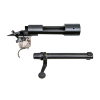All guns are a compromise of the manufacturing methods that were available at the time and you can watch the evolution of how the designs evolved to make them more economical to produce based on current technology. /QUOTE]
And there are also the great leaps forward, like smokeless power and HK / Glock's use of revolutionary polymers.
If we start with a mauser 98 action you see that compared to mid 1900's designs it is fairy complex. They were forged into shape with the bottom of the receiver machined flat./QUOTE said:
Was it an advance in metallurgy, or machining that permitted Mauser to make the leap that they did?
There was no CNC or automated tool changes in this era so every machining operation would be done on a different machine. Because of this there is an effort to reduce the number of machining cuts that have to be made to a minimum. The howa that you mentioned is definitely part of this era of guns designed between WW2 and like the 1990's./quote said:
The gun designs are themselves somewhat dated but I was under the impression the current Howa production facility itself includes state-of-the-art CNC machining, leading to quick and precise results.
Next you have guns that were specifically designed to be made on a CNC machine./quote said:
I can see the advantages inherent to a design intended to be made on a CNC machine, but wouldn't there also be advantages in producing an old design on the CNC platform?
Good examples (complete production using CNC equipment) of this would be the Tikka T3 /quote said:
That's interesting, given Tikka's lineage to Sako and Finnish gunsmiths, among the finest in the world.
The next evolution is rifles like the sig cross where the receiver said:
I wonder also about 3D printing of metals. I visited Naval Air Station San Diego a few years ago and they had set up what looked like a Star Wars fabrication facility, making replacement parts for F/A 18 jets using 3D molten metal printers. It can't be long before gun makers are using the same technologies, if they aren't already.







